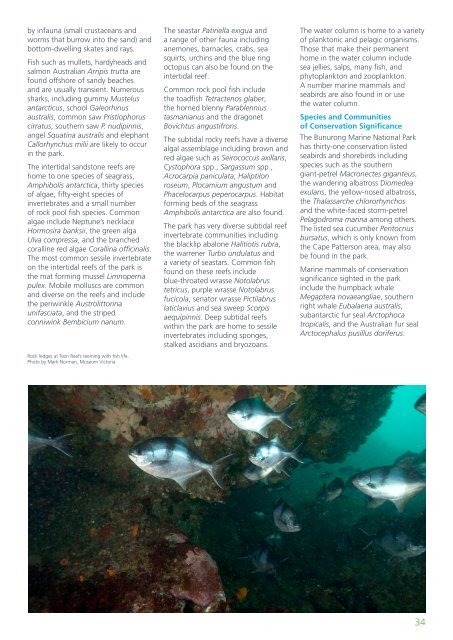Marine Natural Values Study Summary - Parks Victoria
Marine Natural Values Study Summary - Parks Victoria
Marine Natural Values Study Summary - Parks Victoria
You also want an ePaper? Increase the reach of your titles
YUMPU automatically turns print PDFs into web optimized ePapers that Google loves.
y infauna (small crustaceans andworms that burrow into the sand) andbottom-dwelling skates and rays.Fish such as mullets, hardyheads andsalmon Australian Arripis trutta arefound offshore of sandy beachesand are usually transient. Numeroussharks, including gummy Mustelusantarcticus, school Galeorhinusaustralis, common saw Pristiophoruscirratus, southern saw P. nudipinnis,angel Squatina australis and elephantCallorhynchus milii are likely to occurin the park.The intertidal sandstone reefs arehome to one species of seagrass,Amphibolis antarctica, thirty speciesof algae, fifty-eight species ofinvertebrates and a small numberof rock pool fish species. Commonalgae include Neptune’s necklaceHormosira banksii, the green algaUlva compressa, and the branchedcoralline red algae Corallina officinalis.The most common sessile invertebrateon the intertidal reefs of the park isthe mat forming mussel Limnopernapulex. Mobile molluscs are commonand diverse on the reefs and includethe periwinkle Austrolittorinaunifasciata, and the stripedconniwink Bembicium nanum.Rock ledges at Twin Reefs teeming with fish life.Photo by Mark Norman, Museum <strong>Victoria</strong>.The seastar Patiriella exigua anda range of other fauna includinganemones, barnacles, crabs, seasquirts, urchins and the blue ringoctopus can also be found on theintertidal reef.Common rock pool fish includethe toadfish Tetractenos glaber,the horned blenny Parablenniustasmanianus and the dragonetBovichtus angustifrons.The subtidal rocky reefs have a diversealgal assemblage including brown andred algae such as Seirococcus axillaris,Cystophora spp., Sargassum spp.,Acrocarpia paniculata, Haliptilonroseum, Plocamium angustum andPhacelocarpus peperocarpus. Habitatforming beds of the seagrassAmphibolis antarctica are also found.The park has very diverse subtidal reefinvertebrate communities includingthe blacklip abalone Halitiotis rubra,the warrener Turbo undulatus anda variety of seastars. Common fishfound on these reefs includeblue-throated wrasse Notolabrustetricus, purple wrasse Notolabrusfucicola, senator wrasse Pictilabruslaticlavius and sea sweep Scorpisaequipinnis. Deep subtidal reefswithin the park are home to sessileinvertebrates including sponges,stalked ascidians and bryozoans.The water column is home to a varietyof planktonic and pelagic organisms.Those that make their permanenthome in the water column includesea jellies, salps, many fish, andphytoplankton and zooplankton.A number marine mammals andseabirds are also found in or usethe water column.Species and Communitiesof Conservation SignificanceThe Bunurong <strong>Marine</strong> National Parkhas thirty-one conservation listedseabirds and shorebirds includingspecies such as the southerngiant-petrel Macronectes giganteus,the wandering albatross Diomedeaexulans, the yellow-nosed albatross,the Thalassarche chlororhynchosand the white-faced storm-petrelPelagodroma marina among others.The listed sea cucumber Pentocnusbursatus, which is only known fromthe Cape Patterson area, may alsobe found in the park.<strong>Marine</strong> mammals of conservationsignificance sighted in the parkinclude the humpback whaleMegaptera novaeangliae, southernright whale Eubalaena australis,subantarctic fur seal Arctophocatropicalis, and the Australian fur sealArctocephalus pusillus doriferus.34
















